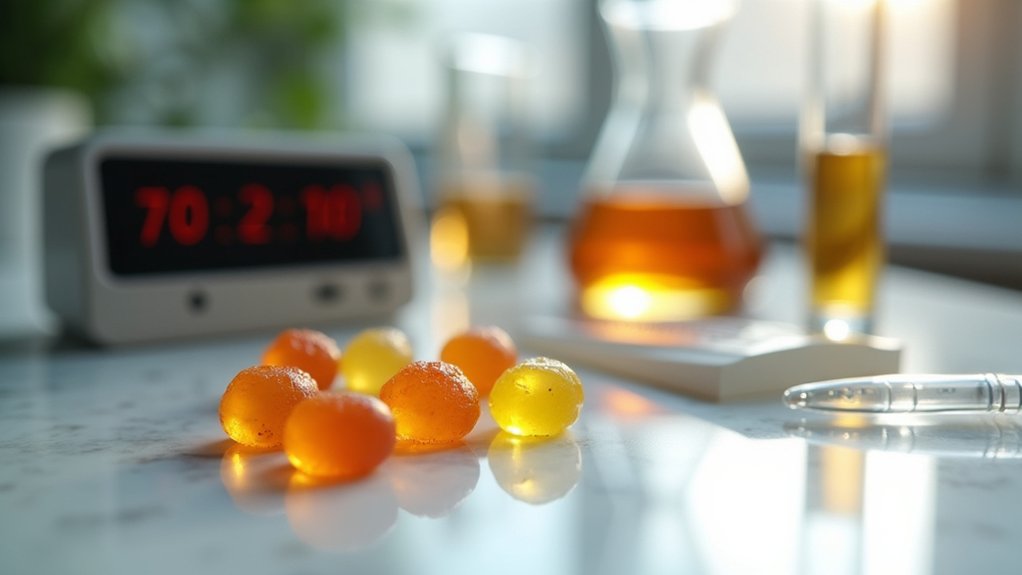When you consume THC edibles, your liver converts
delta-9-THC into
11-hydroxy-THC, a more potent metabolite that crosses the blood-brain barrier efficiently. Urine tests detect
THC-COOH metabolites for 1-7 days in occasional users and 1-4 weeks in frequent consumers, while blood tests reveal acute intoxication for 1-12 hours. Your detection window depends on dose, hepatic enzyme activity, body fat percentage, and genetic polymorphisms affecting CYP2C9 and CYP3A4 metabolism. Understanding these
pharmacokinetic factors helps you anticipate how your unique physiology influences cannabinoid clearance.
Understanding How THC Edibles Are Metabolized in Your Body
When you consume a
THC edible, the cannabinoid commences on a complex
metabolic journey that differs markedly from
inhalation routes. Following gastric breakdown and intestinal absorption, THC enters hepatic circulation via the portal vein, undergoing
first-pass metabolism. Hepatic enzymes, principally CYP2C9 and CYP3A4, convert delta-9-THC into
11-hydroxy-THC, a metabolite exhibiting greater blood-brain barrier permeability and enhanced psychoactive potency. This biotransformation explains why thc edibles metabolism produces delayed yet intensified effects compared to smoking. Subsequently, 11-hydroxy-THC undergoes further oxidation to
THC-COOH, the primary urinary excretion marker. The edible thc elimination rate depends on hepatic function, genetic polymorphisms affecting enzyme activity, body composition, and dosage magnitude. THC's lipophilic nature enables
adipose sequestration, creating prolonged detection windows as gradual lipid mobilization releases stored cannabinoids into systemic circulation over extended periods. The
endocannabinoid system interaction with these metabolized cannabinoids ultimately produces the characteristic physiological and psychoactive effects experienced from edible consumption. Individual variations in
liver enzyme activity can significantly influence how efficiently THC is converted to its metabolites, affecting both the intensity and duration of effects.
Regular cannabis consumption leads to greater THC accumulation in fatty tissues, resulting in extended retention periods compared to occasional users.
Detection Windows for Different Types of Drug Tests
Multiple analytical methodologies exist for detecting THC and its metabolites following edible consumption, each operating within distinct temporal windows determined by specimen matrix, pharmacokinetic disposition, and assay sensitivity. Understanding the THC edibles detection window across biological matrices is essential for interpreting test outcomes. Blood assays detect THC edibles in bloodstream for 1–12 hours, reflecting acute intoxication. Urine immunoassays measure THC-COOH metabolites for 1–30 days, depending on consumption frequency. Saliva tests identify parent THC for up to 24–30 hours. Hair follicle analysis extends detection to 90 days, capturing chronic exposure patterns. THC from edibles metabolism produces lipophilic metabolites that partition into adipose tissue, prolonging systemic clearance and urinary elimination. Urine testing is
considered a reliable test for detecting delta-9-tetrahydrocannabinol and its metabolites in cannabis users.
Blood testing is more invasive but can provide information on the active, unmetabolized drug present during acute intoxication. Saliva testing offers advantages by detecting
presence of parent drugs rather than inactive metabolites, making it useful for assessing recent consumption.
| Test Type |
Detection Window |
| Blood |
1–12 hours |
| Urine |
1–30 days |
| Saliva |
Up to 30 hours |
| Hair |
Up to 90 days |
| Sweat |
7–14 days |
Key Factors That Affect How Long THC Stays Detectable
Because
cannabinoid disposition in human tissues follows complex
pharmacokinetic principles, the duration of THC detectability after edible consumption varies substantially across individuals and testing contexts. Your
marijuana edible detection window depends primarily on dose, higher THC amounts extend retention. Individual metabolism rate governs how quickly liver enzymes degrade cannabinoids, while body fat composition critically influences
edible weed detection time since THC is lipophilic and stored in adipose tissue. Genetic polymorphisms in CYP2C9 and CYP3A4 modify the
THC edible half-life, creating population-level variability. Test sensitivity and cutoff concentrations (15 ng/mL versus 50 ng/mL) dramatically shift positive result windows.
Chronic users retain cannabinoids substantially longer than occasional consumers due to cumulative tissue saturation. A
THC edible duration chart must account for these interacting variables: cumulative
dosage,
metabolic efficiency, adiposity, inherited enzyme function, and
analytical method specificity all determine whether
metabolites remain detectable days or weeks post-ingestion.
Severe dehydration may concentrate THC metabolites in bodily fluids, potentially affecting test results.
Urine testing remains the most prevalent screening method for identifying THC metabolites following edible consumption.
Occasional Users vs. Frequent Users: What to Expect
Your frequency of
edible consumption directly determines
THC metabolite accumulation in adipose tissue, which governs
detection windows across all testing modalities. Occasional users typically clear THC-COOH from urine within 1–7 days due to minimal lipid storage, while frequent users exhibit prolonged retention, often 1–4 weeks or beyond, as repeated dosing saturates fat depots and extends
elimination half-life. Dosage intensity further modulates these timelines: higher-potency gummies accelerate metabolite buildup in chronic users but produce only modest extension in occasional consumers with faster baseline clearance rates. Blood testing reveals
shorter detection windows, with THC typically detectable for only 1-2 days after use regardless of consumption frequency.
Saliva tests can detect THC for up to 24 hours, making them useful for identifying recent consumption patterns.
Hair follicle testing provides the longest detection window, capable of identifying THC presence for up to 90 days following edible consumption.
Occasional User Detection Timelines
For occasional consumers of
THC edibles, typically defined as users who ingest cannabis products once per week or less, detection windows remain considerably shorter than those observed in
frequent users due to limited
cannabinoid accumulation in adipose tissue.
Urine assays typically detect THC metabolites for three to seven days post-ingestion, with most individuals clearing within three days depending on dosage and metabolic rate.
Blood tests show positive results for one to two days, rarely extending to four days. Saliva screenings detect cannabinoids for 24 to 48 hours, occasionally reaching 72 hours.
Hair follicle analysis maintains a 90-day detection window regardless of consumption frequency. Weed brownies detection time mirrors these parameters, as 11-hydroxy-THC, the primary metabolite formed during hepatic first-pass metabolism, persists similarly across edible formats, influenced primarily by individual body composition and hydration status. The
half-life of cannabis typically ranges from 3 to 12 days, meaning the body eliminates approximately half of the THC concentration during this period before subsequent elimination phases continue. When consumed orally,
THC is absorbed through the liver before entering the bloodstream, which differs from inhalation methods where cannabinoids enter directly through lung tissue.
Frequent User Extended Windows
Chronic THC edible consumption fundamentally alters
cannabinoid pharmacokinetics through sustained
metabolite accumulation in adipose tissue, creating detection windows that extend far beyond those observed in occasional users. When you're wondering how long do weed gummies last in your system with daily intake, expect
urine metabolites to persist 30 days to several months due to overlapping clearance cycles. Blood
THC remains detectable for weeks rather than days, while saliva tests extend beyond typical 24-48 hour windows through continuous replenishment.
Hair follicle analysis captures metabolites for 90+ days with regular use. Your body fat percentage, metabolic rate, and hydration influence elimination speed, but
frequency dominates detection duration. The liver converts THC into
11-hydroxy-THC during metabolism, which contributes to the compound's prolonged presence in the body and enhanced potency of effects.
High-potency gummies amplify accumulation, sustaining baseline concentrations in breath and blood even after eight-hour abstinence periods. Regular cannabis users can have
THC in their breath for at least eight hours following consumption.
Dosage Impact on Duration
The quantity of THC you consume directly determines how long metabolites remain detectable through first-pass metabolism and lipophilic accumulation. When you ingest thc chocolates and gummies, higher doses generate heightened 11-hydroxy-THC levels that partition into adipose tissue, extending clearance timelines. Low-dose occasional use typically clears within 1–3 days, while potent edibles can push detection to 30+ days in chronic users.
| Dosage Level |
Urine Detection Window |
| Low (occasional) |
1–3 days |
| Moderate (weekly) |
7–14 days |
| High (daily) |
15–30+ days |
| Single heavy dose |
Up to 7 days |
| Chronic high-dose |
30+ days |
Metabolism rate, body fat percentage, and hepatic function modulate these pharmacokinetic parameters. Blood tests detect THC for 1–4 days post-ingestion, while hair follicle analyses remain positive for 90 days regardless of frequency. Factors such as hydration levels and the sensitivity of the testing methods can also influence the results. Typically,
thc detection time in urine can range from a few days to several weeks, depending on the individual's metabolism and usage patterns.
How Edibles Differ From Smoking or Vaping Cannabis
When you consume edibles, THC undergoes
first-pass hepatic metabolism, converting
delta-9-THC into
11-hydroxy-THC, a more potent and longer-lasting metabolite than what's produced through inhalation. Smoking or vaping delivers THC directly to your bloodstream via
pulmonary absorption, bypassing liver transformation and producing rapid onset with shorter plasma half-life. This metabolic distinction means edibles generate prolonged systemic exposure and extended detection windows compared to inhaled routes, where THC clearance occurs more quickly.
Unlike inhaled cannabis, edibles force THC through your liver before it reaches systemic circulation, a process called
first-pass metabolism that profoundly alters the drug's pharmacokinetics. During thc digestion and absorption, the liver enzyme
CYP2C9 converts delta-9-THC into
11-hydroxy-THC, a metabolite that crosses the
blood-brain barrier more efficiently and produces more intense psychoactive effects. This hepatic transformation reduces
bioavailability to just 4–12%, meaning most ingested THC never reaches your bloodstream unchanged. However, the metabolites that do enter circulation, particularly 11-hydroxy-THC and its breakdown product THC-COOH, persist far longer than inhaled THC. These compounds accumulate in
adipose tissue and release slowly over time, extending detection windows considerably. Your liver's metabolic capacity, enzyme activity, and overall function directly determine both the intensity and duration of edible effects.
Onset and Duration Differences
Route of administration fundamentally determines when and how long you'll experience THC's effects, with edibles diverging dramatically from inhaled cannabis in their pharmacokinetic profile. THC digestion and absorption through your gastrointestinal tract delays onset to 30–120 minutes, contrasting sharply with smoking's near-instantaneous bioavailability. Your liver's first-pass metabolism converts delta-9-THC into 11-hydroxy-THC, producing more intense psychoactive effects lasting 4–12 hours versus inhalation's 1–3 hours.
| Method |
Onset Time |
Duration |
| Edibles |
30–120 minutes |
4–12 hours |
| Smoking/Vaping |
Seconds to minutes |
1–3 hours |
This delayed onset greatly increases overconsumption risk, as you won't perceive effects until substantial THC has already entered systemic circulation. Inhaled methods provide immediate feedback, enabling precise dose titration unavailable with edibles' unpredictable absorption kinetics.
Detection Window Implications
Your body's elimination of
THC metabolites follows markedly different timelines depending on whether you've consumed
edibles or inhaled cannabis, creating substantial disparities in drug test detection windows. THC digestion and absorption through the gastrointestinal tract triggers
hepatic first-pass metabolism, generating
11-OH-THC, a more lipophilic metabolite that exhibits prolonged systemic retention in adipose tissue. This pharmacokinetic pathway extends your detection window greatly:
urine screenings may identify THC-COOH metabolites for 30+ days in chronic edible users, compared to 3–7 days for occasional inhalation users.
Blood tests detect active THC briefly (2–12 hours), yet metabolites from edibles persist longer.
Saliva testing favors recent inhalation detection, while emerging breath-based technologies demonstrate edibles produce delayed, prolonged THC presence. Importantly, standard drug panels cannot distinguish consumption method, meaning edible-derived metabolites trigger identical positive results.
Timeline of Effects: From Onset to Complete Clearance
Most
cannabis edibles initiate their
psychoactive effects within 30 to 90 minutes after ingestion, though this onset window can extend to two hours depending on
gastrointestinal transit time and
hepatic processing capacity. Cannabis digestion and absorption produces
11-hydroxy-THC, a metabolite that intensifies psychoactivity and delays peak plasma concentration to 2–4 hours post-consumption. Effects persist 4–8 hours, occasionally extending to 24 hours in high-dose scenarios.
Detection windows vary by biological matrix: saliva tests reveal THC for 24–72 hours, blood tests for 1–4 days, and urine tests for 3–30+ days depending on usage frequency. Hair follicle analysis detects metabolites up to 90 days.
Clearance rates depend on lipid storage capacity, metabolic efficiency, and consumption patterns, occasional users typically eliminate detectable metabolites within 3–7 days, while chronic consumers may require several weeks. Moreover, various factors can influence
how long oils stay detectable in the system, including the type of oil used and individual variations in metabolism. Individuals with higher body fat percentages may retain metabolites for longer periods due to the storage of THC in adipose tissues.
Common Myths and Misconceptions About THC Detection
Widespread misunderstandings about
THC detection persist despite established
pharmacokinetic data on
cannabinoid metabolism and elimination. You can't reliably accelerate THC metabolite clearance through detox products or excessive hydration, metabolism dictates elimination kinetics regardless of commercial claims.
Detection windows vary considerably across
testing methodologies: urine, blood, saliva, and hair samples each measure different cannabinoid concentrations and timeframes.
Passive exposure to cannabis smoke rarely triggers positive results because laboratory cutoff thresholds distinguish intentional consumption from incidental contact. Your body composition influences retention, but
metabolic rate and usage frequency ultimately determine clearance patterns more than fat percentage alone. Modern laboratories employ integrity checks that detect
sample manipulation attempts, rendering substitution or dilution ineffective. Whether you consume THC drinks and infused beverages or traditional edibles, individual pharmacokinetic variability makes universal detection predictions unreliable without considering dosage, frequency, and physiological factors.
Frequently Asked Questions
Can Secondhand Exposure to Cannabis Edibles Cause a Positive Drug Test?
No, you can't test positive from
secondhand exposure to cannabis edibles. Unlike smoked cannabis, edibles don't release
airborne THC, there's no vapor or smoke for you to inhale passively. THC from edibles enters the user's bloodstream via
first-pass metabolism in the liver, creating no environmental contamination. No pharmacological mechanism exists for
passive THC transfer through edible consumption, and no documented cases support this possibility. You'll only test positive if you directly ingest THC-containing products yourself.
Do CBD Gummies Without THC Show up on Standard Drug Tests?
CBD gummies without THC won't show up on standard drug tests because these screenings target
THC metabolites, not cannabidiol. If you're using CBD isolate or verified THC-free broad-spectrum products with
third-party lab testing, you shouldn't trigger a positive result. However, contamination or mislabeling can introduce trace THC into your system. Always review the
Certificate of Analysis to verify zero THC content, this eliminates detection risk and corroborates you're consuming what's advertised.
Will Drinking More Water Help Flush THC From Edibles Faster?
No, drinking more water won't accelerate
THC elimination from your body. Since THC metabolites are
lipophilic and stored in adipose tissue, hydration doesn't enhance their
metabolic clearance or excretion rate. Water intake only dilutes urine concentration temporarily, which may lower detectable metabolite levels but risks sample invalidation through abnormal creatinine ratios. The hepatic metabolism and gradual release from fat stores remain unaffected by hydration status. Time and abstinence are the only
evidence-based methods for clearing THC after edible consumption.
Can Prescription Medications Affect How Long THC From Edibles Stays Detectable?
Yes,
prescription medications can profoundly affect
THC detectability. Drugs that induce or inhibit CYP450 enzymes alter
THC metabolism, accelerators shorten detection windows while inhibitors prolong them. Medications affecting lipid metabolism, renal function, or adipose mobilization influence how long THC remains stored and excreted. Additionally, certain prescriptions cause false positives or negatives on immunoassay screens through cross-reactivity. Your individual medication regimen, liver/kidney function, and metabolic enzyme activity directly impact
THC elimination kinetics and detection duration.
Do Hair Follicle Tests Differentiate Between One-Time and Regular Edible Use?
No,
hair follicle tests can't differentiate between one-time and regular edible use. They detect cumulative THC metabolite concentrations over approximately
90 days but don't pinpoint frequency or usage patterns. While
chronic users accumulate higher metabolite levels, increasing detection likelihood, no industry-standard threshold distinguishes a single high-dose edible from repeated low-dose consumption. Test results simply indicate "use within 90 days." Your metabolic rate, dosage, and hair characteristics influence detection, but interpreting frequency from hair analysis alone remains
scientifically unreliable.
 When you consume a THC edible, the cannabinoid commences on a complex metabolic journey that differs markedly from inhalation routes. Following gastric breakdown and intestinal absorption, THC enters hepatic circulation via the portal vein, undergoing first-pass metabolism. Hepatic enzymes, principally CYP2C9 and CYP3A4, convert delta-9-THC into 11-hydroxy-THC, a metabolite exhibiting greater blood-brain barrier permeability and enhanced psychoactive potency. This biotransformation explains why thc edibles metabolism produces delayed yet intensified effects compared to smoking. Subsequently, 11-hydroxy-THC undergoes further oxidation to THC-COOH, the primary urinary excretion marker. The edible thc elimination rate depends on hepatic function, genetic polymorphisms affecting enzyme activity, body composition, and dosage magnitude. THC's lipophilic nature enables adipose sequestration, creating prolonged detection windows as gradual lipid mobilization releases stored cannabinoids into systemic circulation over extended periods. The endocannabinoid system interaction with these metabolized cannabinoids ultimately produces the characteristic physiological and psychoactive effects experienced from edible consumption. Individual variations in liver enzyme activity can significantly influence how efficiently THC is converted to its metabolites, affecting both the intensity and duration of effects. Regular cannabis consumption leads to greater THC accumulation in fatty tissues, resulting in extended retention periods compared to occasional users.
When you consume a THC edible, the cannabinoid commences on a complex metabolic journey that differs markedly from inhalation routes. Following gastric breakdown and intestinal absorption, THC enters hepatic circulation via the portal vein, undergoing first-pass metabolism. Hepatic enzymes, principally CYP2C9 and CYP3A4, convert delta-9-THC into 11-hydroxy-THC, a metabolite exhibiting greater blood-brain barrier permeability and enhanced psychoactive potency. This biotransformation explains why thc edibles metabolism produces delayed yet intensified effects compared to smoking. Subsequently, 11-hydroxy-THC undergoes further oxidation to THC-COOH, the primary urinary excretion marker. The edible thc elimination rate depends on hepatic function, genetic polymorphisms affecting enzyme activity, body composition, and dosage magnitude. THC's lipophilic nature enables adipose sequestration, creating prolonged detection windows as gradual lipid mobilization releases stored cannabinoids into systemic circulation over extended periods. The endocannabinoid system interaction with these metabolized cannabinoids ultimately produces the characteristic physiological and psychoactive effects experienced from edible consumption. Individual variations in liver enzyme activity can significantly influence how efficiently THC is converted to its metabolites, affecting both the intensity and duration of effects. Regular cannabis consumption leads to greater THC accumulation in fatty tissues, resulting in extended retention periods compared to occasional users.
 Because cannabinoid disposition in human tissues follows complex pharmacokinetic principles, the duration of THC detectability after edible consumption varies substantially across individuals and testing contexts. Your marijuana edible detection window depends primarily on dose, higher THC amounts extend retention. Individual metabolism rate governs how quickly liver enzymes degrade cannabinoids, while body fat composition critically influences edible weed detection time since THC is lipophilic and stored in adipose tissue. Genetic polymorphisms in CYP2C9 and CYP3A4 modify the THC edible half-life, creating population-level variability. Test sensitivity and cutoff concentrations (15 ng/mL versus 50 ng/mL) dramatically shift positive result windows. Chronic users retain cannabinoids substantially longer than occasional consumers due to cumulative tissue saturation. A THC edible duration chart must account for these interacting variables: cumulative dosage, metabolic efficiency, adiposity, inherited enzyme function, and analytical method specificity all determine whether metabolites remain detectable days or weeks post-ingestion. Severe dehydration may concentrate THC metabolites in bodily fluids, potentially affecting test results. Urine testing remains the most prevalent screening method for identifying THC metabolites following edible consumption.
Because cannabinoid disposition in human tissues follows complex pharmacokinetic principles, the duration of THC detectability after edible consumption varies substantially across individuals and testing contexts. Your marijuana edible detection window depends primarily on dose, higher THC amounts extend retention. Individual metabolism rate governs how quickly liver enzymes degrade cannabinoids, while body fat composition critically influences edible weed detection time since THC is lipophilic and stored in adipose tissue. Genetic polymorphisms in CYP2C9 and CYP3A4 modify the THC edible half-life, creating population-level variability. Test sensitivity and cutoff concentrations (15 ng/mL versus 50 ng/mL) dramatically shift positive result windows. Chronic users retain cannabinoids substantially longer than occasional consumers due to cumulative tissue saturation. A THC edible duration chart must account for these interacting variables: cumulative dosage, metabolic efficiency, adiposity, inherited enzyme function, and analytical method specificity all determine whether metabolites remain detectable days or weeks post-ingestion. Severe dehydration may concentrate THC metabolites in bodily fluids, potentially affecting test results. Urine testing remains the most prevalent screening method for identifying THC metabolites following edible consumption.
 Widespread misunderstandings about THC detection persist despite established pharmacokinetic data on cannabinoid metabolism and elimination. You can't reliably accelerate THC metabolite clearance through detox products or excessive hydration, metabolism dictates elimination kinetics regardless of commercial claims. Detection windows vary considerably across testing methodologies: urine, blood, saliva, and hair samples each measure different cannabinoid concentrations and timeframes. Passive exposure to cannabis smoke rarely triggers positive results because laboratory cutoff thresholds distinguish intentional consumption from incidental contact. Your body composition influences retention, but metabolic rate and usage frequency ultimately determine clearance patterns more than fat percentage alone. Modern laboratories employ integrity checks that detect sample manipulation attempts, rendering substitution or dilution ineffective. Whether you consume THC drinks and infused beverages or traditional edibles, individual pharmacokinetic variability makes universal detection predictions unreliable without considering dosage, frequency, and physiological factors.
Widespread misunderstandings about THC detection persist despite established pharmacokinetic data on cannabinoid metabolism and elimination. You can't reliably accelerate THC metabolite clearance through detox products or excessive hydration, metabolism dictates elimination kinetics regardless of commercial claims. Detection windows vary considerably across testing methodologies: urine, blood, saliva, and hair samples each measure different cannabinoid concentrations and timeframes. Passive exposure to cannabis smoke rarely triggers positive results because laboratory cutoff thresholds distinguish intentional consumption from incidental contact. Your body composition influences retention, but metabolic rate and usage frequency ultimately determine clearance patterns more than fat percentage alone. Modern laboratories employ integrity checks that detect sample manipulation attempts, rendering substitution or dilution ineffective. Whether you consume THC drinks and infused beverages or traditional edibles, individual pharmacokinetic variability makes universal detection predictions unreliable without considering dosage, frequency, and physiological factors.















